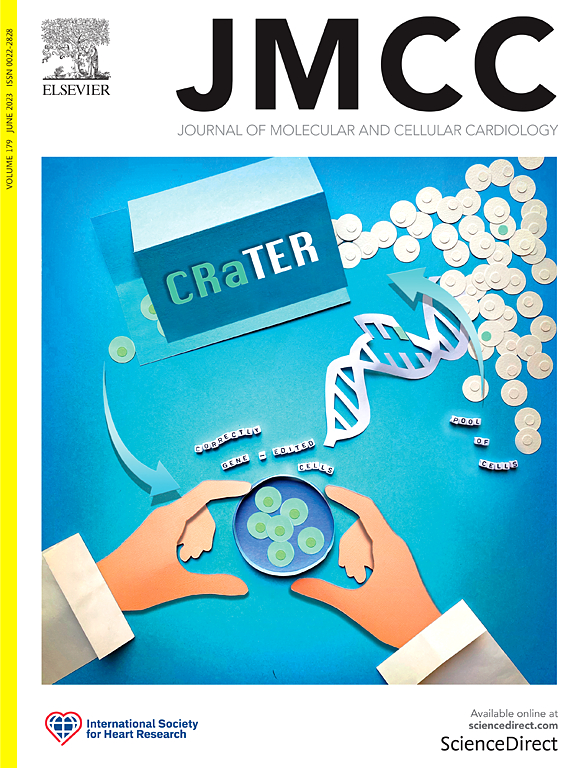LncRNA 91,234.1靶向PRMT1/ASCL4/GPX4轴调控甲醛诱导的心肌细胞铁下垂和先天性心脏病
IF 4.7
2区 医学
Q1 CARDIAC & CARDIOVASCULAR SYSTEMS
引用次数: 0
摘要
先天性心脏病(CHD)是新生儿死亡的主要原因,也是最普遍的先天性畸形。此外,冠心病会影响成年人的心血管健康,并加剧老年人的心血管疾病。新出现的研究表明,遗传倾向和环境因素都可能导致这种情况的发展。值得注意的是,甲醛(FA),一种普遍存在的环境毒素,通过最近的研究越来越多地涉及冠心病的病理生理。早些时候,我们发现长链非编码rna (lncRNAs)在与FA暴露相关的心脏发育障碍大鼠中表现出显著的差异表达。本研究旨在通过将H9C2细胞暴露于24小时甲醛或对雌性大鼠给予甲醛(2.0 mg/kg)并检查其后代,阐明lncRNA在病理机制中的作用。我们发现lncRNA 91,234.1 (lncRNA 91234)在fa诱导的冠心病中发挥作用,通过PRMT1/ASCL4/GPX4轴促进铁凋亡,影响H4R3的甲基化,导致脂质过氧化和丙二醛(MDA)积累。这项研究首次证明了暴露于FA通过铁上沉破坏心功能,并确定了lnc91234作为一种新的lncRNA,可能通过调节体内和体外心肌功能作为心脏发育不良和冠心病的潜在治疗靶点。本文章由计算机程序翻译,如有差异,请以英文原文为准。

LncRNA 91234.1 targets PRMT1/ASCL4/GPX4 axis to regulate formaldehyde-induced cardiomyocyte ferroptosis and congenital heart disease
Congenital heart disease (CHD) are the predominant cause of neonatal mortality and the most prevalent congenital malformation. Additionally, CHD can impact cardiovascular health in adulthood and exacerbate cardiovascular conditions in the elderly. Emerging studies indicate that both genetic predispositions and environmental factors may contribute to the development of this condition. Notably, formaldehyde (FA), a ubiquitous environmental toxin, has been increasingly implicated in the pathophysiology of CHD through recent investigations. Earlier, we identified long noncoding RNAs (lncRNAs) that exhibited significant differential expression in rats with cardiac developmental impairments associated with FA exposure. Here our study aims to elucidate the role of lncRNA in pathological mechanisms by subjecting H9C2 cells to 24-h formaldehyde exposure or administering formaldehyde (2.0 mg/kg) to female rats and examining their offspring. We indicate that lncRNA 91,234.1 (lnc91234) plays a role in FA-induced CHD by facilitating ferroptosis via PRMT1/ASCL4/GPX4 axis, which influences the methylation of H4R3, leading to lipid peroxidation and malondialdehyde (MDA) accumulation. This research is the first to demonstrate that exposure to FA disrupts cardiac function through ferroptosis and identifies lnc91234 as a novel lncRNA that may serve as a potential therapeutic target for cardiac dysplasia and CHD by modulating myocardial function both in vivo and in vitro.
求助全文
通过发布文献求助,成功后即可免费获取论文全文。
去求助
来源期刊
CiteScore
10.70
自引率
0.00%
发文量
171
审稿时长
42 days
期刊介绍:
The Journal of Molecular and Cellular Cardiology publishes work advancing knowledge of the mechanisms responsible for both normal and diseased cardiovascular function. To this end papers are published in all relevant areas. These include (but are not limited to): structural biology; genetics; proteomics; morphology; stem cells; molecular biology; metabolism; biophysics; bioengineering; computational modeling and systems analysis; electrophysiology; pharmacology and physiology. Papers are encouraged with both basic and translational approaches. The journal is directed not only to basic scientists but also to clinical cardiologists who wish to follow the rapidly advancing frontiers of basic knowledge of the heart and circulation.

 求助内容:
求助内容: 应助结果提醒方式:
应助结果提醒方式:


